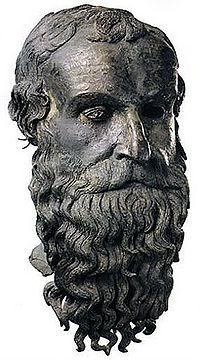
Head of a Philosopher
Encyclopedia

Ancient Greek
Ancient Greek is the stage of the Greek language in the periods spanning the times c. 9th–6th centuries BC, , c. 5th–4th centuries BC , and the c. 3rd century BC – 6th century AD of ancient Greece and the ancient world; being predated in the 2nd millennium BC by Mycenaean Greek...
bronze sculpture produced in Magna Graecia
Magna Graecia
Magna Græcia is the name of the coastal areas of Southern Italy on the Tarentine Gulf that were extensively colonized by Greek settlers; particularly the Achaean colonies of Tarentum, Crotone, and Sybaris, but also, more loosely, the cities of Cumae and Neapolis to the north...
. It is part-damaged, lacking its laurel wreath, left eye and the hair on the back of its head, while the mangled fragments of a hand and a cloak were found with it, which has led to the head's identification as a philosopher. It was discovered in 1969 in a wreck off Porticello beach at Cannitello, north of Reggio Calabria
Reggio Calabria
Reggio di Calabria , commonly known as Reggio Calabria or Reggio, is the biggest city and the most populated comune of Calabria, southern Italy, and is the capital of the Province of Reggio Calabria and seat of the Council of Calabrian government.Reggio is located on the "toe" of the Italian...
. It is now held at the Museo Nazionale della Magna Grecia
Museo Nazionale della Magna Grecia
The Museo Nazionale della Magna Grecia , Museo Archeologico Nazionale di Reggio Calabria or Palazzo Piacentini is a museum in Reggio Calabria, southern Italy, housing an archaeological collection from sites in Magna Graecia.Initially formed with a nucleus of material ceded from the...
in Reggio.

